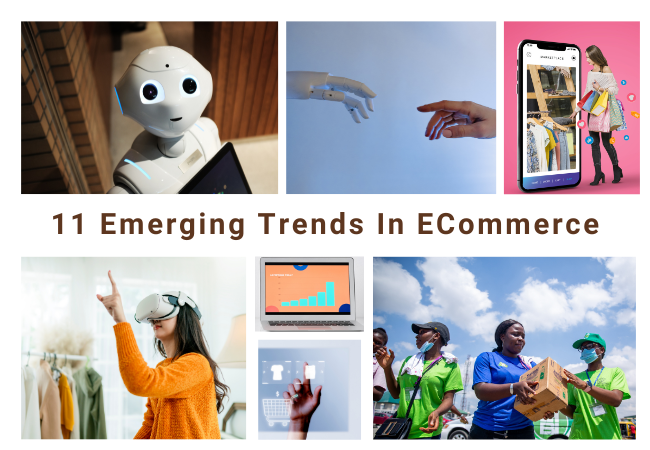Introduction: The Ever-Evolving Recent Trends in Ecommerce
The world of ecommerce is constantly evolving, driven by technological advancements and changing consumer behaviors. As we move forward, it is crucial for businesses to stay ahead of the curve and embrace the emerging trends in Ecommerce that are reshaping the landscape. Let’s explore the most significant developments in the ecommerce industry and how they are influencing the future of online shopping. From voice commerce and augmented reality to sustainability and social commerce, let’s delve into these recent trends in ecommerce that are propelling the industry forward. The Ecommerce future in India holds great promise as the nation witnesses a surge in online shopping. Emerging trends in ecommerce, such as voice commerce, augmented reality, and social commerce, are reshaping the industry. With a tech-savvy population and expanding digital infrastructure, India’s ecommerce landscape is poised for remarkable growth and innovation.

Voice Commerce: Revolutionizing Online Shopping with Voice Assistants
One of the most groundbreaking emerging trends in ecommerce is voice commerce, which is transforming the ecommerce future in India the way customers interact with online stores. With the widespread adoption of voice assistants like Siri, Alexa, and Google Assistant, consumers can now make purchases using simple voice commands. This hands-free and convenient shopping experience has garnered immense popularity, especially among busy individuals who seek a seamless way to shop while multitasking. By optimizing their platforms for voice search, ecommerce businesses can cater to this growing market segment and ensure a user-friendly shopping experience for their customers.
Augmented Reality (AR) and Virtual Reality (VR) in Ecommerce: Immersive Shopping Experiences
Another exciting trend revolutionizing ecommerce future in India is the integration of augmented reality and virtual reality technologies. AR and VR offer customers the opportunity to virtually experience products before making a purchase, eliminating uncertainties and boosting confidence in their buying decisions. From trying on virtual apparel to visualizing furniture in their homes, AR and VR create immersive and engaging shopping experiences. By incorporating these technologies into their platforms, ecommerce businesses can enhance customer satisfaction and differentiate themselves from competitors.
Personalization: Creating Tailored Ecommerce Journeys for Each Customer
In the era of personalization, catering to individual customer preferences is paramount for ecommerce success. By leveraging data analytics and artificial intelligence, businesses can offer personalized product recommendations and tailored shopping journeys. Understanding customer behavior and preferences allows ecommerce platforms to deliver relevant content and offers, which not only enhances customer satisfaction but also boosts conversion rates and fosters long-term loyalty.
Social Commerce: Harnessing the Power of Social Media for Online Retail
The rise of social media has led to the convergence of social interactions and online shopping, giving birth to the trend of social commerce. Ecommerce businesses are leveraging social media platforms as virtual marketplaces, enabling customers to shop directly from their favorite social channels. By strategically using “shoppable posts” and influencer marketing, brands can reach a broader audience and tap into the power of social influence to drive sales.
Sustainability in Ecommerce: Eco-Friendly Practices and Ethical Consumerism
Sustainability has become a critical consideration for both consumers and businesses. Eco-conscious shoppers are seeking products and services that align with their values, leading to the emergence of sustainable ecommerce practices. From eco-packaging and carbon-neutral shipping to supporting ethically sourced products, ecommerce companies are adopting green initiatives to appeal to environmentally-conscious customers and build a positive brand image.
Same-Day and One-Hour Delivery: Speeding Up Ecommerce Fulfillment
Instant gratification has become a driving force in the ecommerce world, with customers expecting swift delivery of their purchases. To meet these demands, ecommerce businesses are embracing same-day and one-hour delivery options. This trend requires strategic partnerships with local delivery services and efficient logistics systems to fulfill orders promptly. By providing rapid delivery services, businesses can delight customers and gain a competitive advantage in the market.
Mobile Commerce (M-Commerce): The Mobile-First Approach to Shopping
With the proliferation of smartphones and tablets, mobile commerce (M-commerce) has become a dominant force in the ecommerce industry. Customers now prefer shopping on their mobile devices due to the convenience and accessibility they offer. Ecommerce platforms must optimize their websites and apps for mobile devices to provide a seamless shopping experience on smaller screens. Additionally, mobile wallets, such as Apple Pay and Google Pay, are gaining popularity, simplifying the checkout process for mobile shoppers.
Subscription-Based Ecommerce: Convenience, Loyalty, and Recurring Revenue
Subscription-based ecommerce models are the most recent emerging trends in ecommerce especially in India and have gained significant traction in recent years, offering customers recurring supplies of products or services. These subscriptions provide convenience and cost savings, while also fostering customer loyalty. Ecommerce businesses can benefit from a more predictable revenue flow and higher customer retention rates through well-designed subscription models.
Enhanced Payment Security: Ensuring Trust and Safety in Online Transactions
As digital transactions become more prevalent, payment security is a paramount concern for customers. Ecommerce businesses must prioritize the implementation of robust security measures, such as multi-factor authentication and tokenization, to protect sensitive customer information and prevent fraudulent activities. Establishing trust and confidence in online transactions is essential for encouraging more customers to shop online.
Artificial Intelligence (AI) and Machine Learning in Ecommerce: Smart and Predictive Solutions
AI and machine learning technologies are revolutionizing ecommerce by enabling smart and predictive solutions. Ecommerce platforms leverage these technologies to analyze customer data, predict purchasing behaviors, and provide personalized product recommendations. Additionally, AI-powered chatbots offer efficient customer support, enhancing the overall shopping experience.
Cryptocurrency and Blockchain: Exploring the Future of Ecommerce Transactions
Cryptocurrency and blockchain technology are making waves in the ecommerce industry. Blockchain offers secure and transparent transaction processing, reducing the risk of fraud and chargebacks. Additionally, accepting cryptocurrencies as payment options expands the customer base, especially among tech-savvy consumers interested in decentralized finance solutions.
Socially Responsible Ecommerce: Supporting Causes and Giving Back
Consumers today are increasingly drawn to brands that demonstrate social responsibility and actively support meaningful causes. Ecommerce businesses can make a positive impact by donating a portion of their profits to charity or aligning with social initiatives. By doing so, they not only attract socially conscious consumers but also create a sense of purpose and connection with their customer base.
Live Commerce: Real-Time Shopping Experiences for Customers
Live commerce is a rapidly growing trend that involves real-time interactive shopping experiences through live streaming. Ecommerce businesses can host live events showcasing products, giving customers the opportunity to ask questions and make purchases directly during the stream. Live commerce bridges the gap between online and in-store experiences, creating a dynamic and engaging platform for customers.
Ecommerce Marketplaces: Expanding Reach and Global Opportunities
Ecommerce marketplaces offer a vast ecosystem for businesses to reach a broader audience and tap into global markets. By listing products on platforms like Amazon, eBay, and Alibaba, businesses can benefit from increased visibility and access to a diverse customer base. However, effective marketplace strategies are essential to stand out in a competitive environment.
Inclusive Ecommerce: Catering to Diverse Audiences and Accessibility
Inclusive ecommerce focuses on creating an accessible and user-friendly shopping experience for all customers, regardless of their abilities. Ecommerce businesses can enhance accessibility by incorporating features like screen readers, voice commands, and color contrast adjustments. By accommodating diverse audiences, businesses can build a loyal customer base and foster a sense of inclusivity.
Voice Search Optimization: Navigating the Voice-First Ecommerce Landscape
As voice commerce gains traction, optimizing ecommerce platforms for voice search is crucial for staying competitive. Voice search optimization involves tailoring product descriptions and content to match the conversational nature of voice queries. Ecommerce businesses can benefit from voice-driven traffic and increase conversions by being at the forefront of voice search results.
Ecommerce Analytics and Big Data: Leveraging Insights for Growth
Data analytics and big data play a vital role in shaping ecommerce strategies and decision-making. Ecommerce businesses can harness valuable insights from customer behavior, preferences, and buying patterns to refine marketing campaigns, improve inventory management, and enhance the overall customer experience.
User-Generated Content: Building Trust and Engagement in Ecommerce
User-generated content (UGC) has emerged as a powerful tool for ecommerce businesses to build trust and engagement. Reviews, ratings, and customer testimonials provide social proof and influence purchasing decisions. Encouraging customers to share their experiences and feedback not only fosters brand loyalty but also attracts new customers through authentic endorsements.
Influencer Marketing in Ecommerce: Leveraging Social Influence for Sales
Influencer marketing has become an integral part of ecommerce strategies, as influencers hold sway over their followers’ purchasing decisions. Ecommerce businesses collaborate with influencers to promote their products and services to a targeted audience. By leveraging the influence of social media stars and content creators, brands can boost visibility and drive sales.
Ecommerce Automation: Streamlining Operations and Efficiency
Automation is revolutionizing ecommerce operations by streamlining repetitive tasks and improving efficiency. Ecommerce businesses can automate inventory management, order processing, and customer service, freeing up resources for more strategic initiatives. Automation not only reduces manual errors but also allows businesses to focus on growth and innovation.
Chatbots and Virtual Assistants: One of the Most Recent Trends in Ecommerce
Chatbots and virtual assistants are becoming increasingly prevalent in ecommerce, offering round-the-clock customer support and instant responses to inquiries. These AI-powered tools enable businesses to provide prompt and efficient assistance, improving the overall customer experience and fostering customer satisfaction.
Micro-Moments in Ecommerce: Capitalizing on Instant Decision-Making
Micro-moments refer to the brief periods when consumers turn to their devices to make immediate decisions. Ecommerce businesses can capitalize on these moments by delivering relevant and timely content, such as personalized offers or flash sales. By meeting customers’ needs at these critical junctures, businesses can influence purchasing decisions and drive conversions.
Cross-Border Ecommerce: Breaking Barriers and Expanding Internationally
Cross-border ecommerce provides a large pool of opportunities for businesses to expand their reach internationally. However, it also comes with challenges related to language barriers, payment methods, and shipping logistics. By strategically navigating these barriers, ecommerce businesses can tap into new markets and unlock international growth.
Conclusion: Embracing the Future of Ecommerce and Navigating the Path to Success
The ecommerce landscape is in a constant state of flux, driven by technological advancements and evolving consumer preferences. Embracing emerging trends in ecommerce is not just a choice but a necessity for businesses aiming to thrive in the future. From voice commerce and augmented reality to sustainability and social commerce, staying ahead of the curve is key to standing out in the competitive online marketplace. By integrating these trends into their strategies, ecommerce businesses can create remarkable shopping experiences that cater to the needs of modern consumers, ensuring a prosperous and successful future in the dynamic world of ecommerce.

